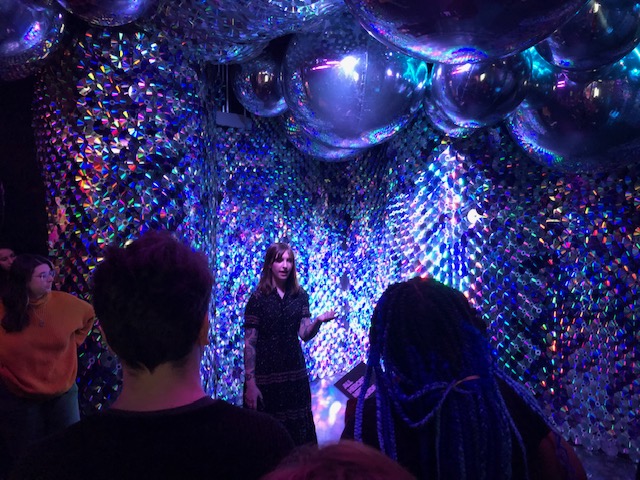
by Samantha Sartori
In grad school, we read a lot of case studies.
This quarter in our Business Models course, we’re discovering the importance for companies to be able to shift their business model when the time is right.
So when we took a visit to wndr museum and met with their team, it ended up being a live case study for us. We saw first-hand how this local, interactive art museum is learning to shift its model.
Wndr museum originally opened in September 2018 as a pop-up exhibition in Chicago’s West Loop. The initial plan was temporary: to run for a few months with a mix of art-and-science inspired exhibits, featuring Yayoi Kusama’s “Let’s Survive Together” Infinity Mirror Room. However, their team quickly noticed visitor numbers were higher than expected. After assessing ticket sales and the museum’s organic following, the team realized there was a place in the Chicago cultural market for wndr to stay.
This shift from a pop-up experience to a permanent museum requires a whole new strategy for wndr. Once the decision was made to stay, Ashley Vogel, wndr’s creative manager, says the team had to shift their thinking from “this will work for now” to “this needs to last long-term.” Many of the exhibitions for wndr’s first chapter FINITE/INFINITE were only built to last a few months. With interaction being at the forefront for all exhibits, the creative team now needs to consider a bit more longevity when planning for future ones.
 The initial plan targeted an audience focused on more “Instagrammable” moments since the museum’s business model was short-term. Once wndr shifted to a long-term focus, the team realized exhibits needed to be more immersive and interactive, while maintaining durability. (They are still very photo-friendly though; that part isn’t going away.)
The initial plan targeted an audience focused on more “Instagrammable” moments since the museum’s business model was short-term. Once wndr shifted to a long-term focus, the team realized exhibits needed to be more immersive and interactive, while maintaining durability. (They are still very photo-friendly though; that part isn’t going away.)
Included in this new business model is a focus on community awareness, according to Vogel. As she works on crafting brand partnerships and marketing wndr, she says the community needs to know wndr is here to stay.
A big part of that new model revolves around programming, something that wndr didn’t have to initially consider. Hannah Parker, who started as a production assistant for wndr and has worked her way into a new role as events and programming manager, says she’s focused on making the space accessible for everyone. To engage the community — both new visitors and repeat guests — wndr is growing its events calendar. This includes family-oriented events, like showing Sunday morning cartoons, and adults-only events, like happy hours and staying open late for the wndr After Dark series. Plus, they’re even hosting collaborative events with other creative entities in Chicago, like Sofar Sounds for intimate concerts.
Even with the new business model, wndr hasn’t forgotten about its core purpose: art and showcasing new artists. Assistant Curator Siobhan Schuck says “wndr is creating new models for museums to work with artists,” as she works along with Curatorial Coordinator Hannah Shanker to find artists to collaborate with and create artwork for the museum.
“A lot of people don’t realize they’re interacting with art,” said Shanker. To grow their audience and get visitors to come back again and again, the team studies which exhibits are resonating the most with audiences. From sound projection installations, disco-party buttons in the bathroom, and artist-in-residency programs, wndr’s team is constantly developing new ways to engage with audiences.
Much of the team is getting their first professional job experience at wndr. “Start-ups are a good opportunity for quick career growth,” said Gabi Thiam, who manages the office and focuses on community engagement. Since joining wndr as an ambassador, she’s worn a lot of hats and stepped into different roles to help her build her professional toolkit.
The whole team echoed Thiam when it came to the museum’s start-up culture. They’ve all learned to be scrappy and work quickly to switch out exhibits, but that’s all part of the fun. The team knows its business model is flexible and they need to be ready to adapt and change at a moment’s notice — perhaps shifting as often as their exhibits.